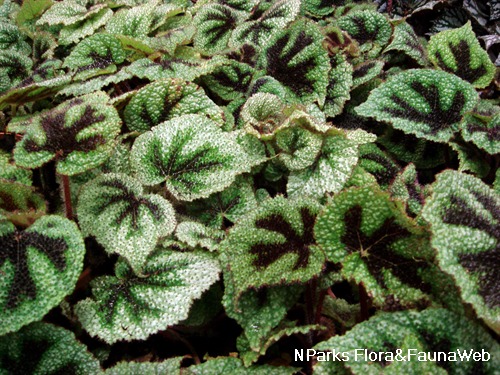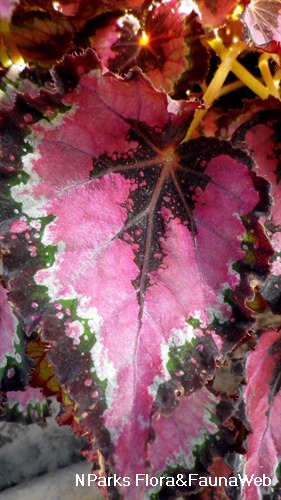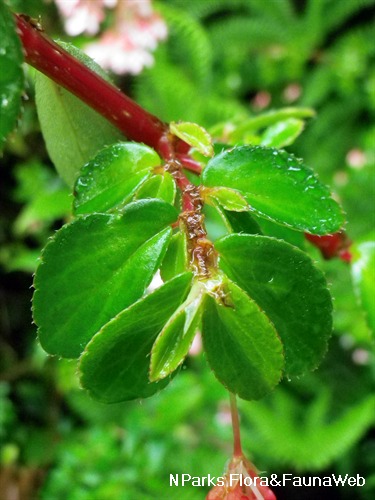-(1).jpg)
Name
Classifications and Characteristics
| Plant Division | Angiosperms (Flowering Seed Plants) |
|---|---|
| Plant Growth Form | Herbaceous Plant |
Biogeography
| Native Distribution | India, China, New Guinea |
|---|
Description and Ethnobotany
| Growth Form | A rhizomatous, perennial herb that forms dense, upright clumps up to 70 cm tall. |
|---|---|
| Foliage | Green leaves have a brown, cross-like patch that occurs near the main veins and darkens with age. They are large, asymmetrical and approximately ovate to round. Wrinkled, leathery leaves are densely covered in hair. |
| Flowers | Small, pale green flowers are unisexual. Flowers are arranged in branched inflorescences known as panicles. Both male and female flowers are found within the same cluster. |
| Habitat | Occurs in dry, subtropical to tropical forests. Often found on limestone rocks or shallow leaf litter. |
| Cultivation | This species grows best under bright filtered lighting, as direct sunlight will cause leaf scorch. Plant in well-drained, porous soil, because the rhizome is prone to rotting in waterlogged soil. Allow the soil to dry between waterings. Keep the leaves dry to prevent leaf spot. Fertilize plants every two weeks with quarter-strength balanced complete liquid fertilizer (23-19-14). Plants will grow best in a humid environment. Leaf tips and margins that become brown is a sign of insufficient humidity. Increase humidity by placing potted plants on a tray of wet pebbles or using a room humidifier, but ensure adequate air flow to prevent fungal diseases, such as mildew and botrytis. Optimum growth temperature for this species is about 18 to 24 °C. Pinch the branch tips to prevent plants from becoming leggy. |
| Etymology | The genus "Begonia" was named after Michel Begon (1638 - 1710), a French patron of botany and former governor of Haiti (then called Santo Domingo). |
Landscaping Features
| Desirable Plant Features | Ornamental Foliage |
|---|---|
| Landscape Uses | Interiorscape/ Indoor Plant, Container Planting, Suitable for Hanging Baskets |
Plant Care and Propagation
| Light Preference | Semi-Shade, Full Shade |
|---|---|
| Water Preference | Moderate Water |
| Rootzone Tolerance | Well-Drained Soils, Fertile Loamy Soils |
| Propagation Method | Seed, Leaf Cutting, Division |
Foliar
| Mature Foliage Colour(s) | Brown, Green |
|---|---|
| Mature Foliage Texture(s) | Hairy / Hirsute, Leathery, Bulging in between Veins |
| Foliar Shape(s) | Non-Palm Foliage (Orbicular / Round) |
Floral (Angiosperm)
| Flower Colour(s) | White |
|---|
Image Repository
Others
| Master ID | 29304 |
|---|---|
| Species ID | 3613 |
| Flora Disclaimer | The information in this website has been compiled from reliable sources, such as reference works on medicinal plants. It is not a substitute for medical advice or treatment and NParks does not purport to provide any medical advice. Readers should always consult his/her physician before using or consuming a plant for medicinal purposes. |

.jpg)




